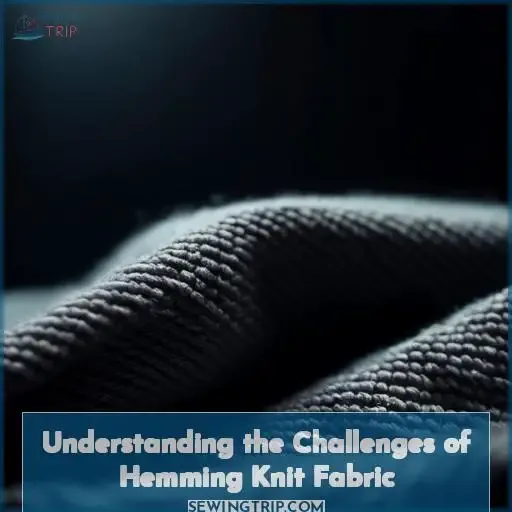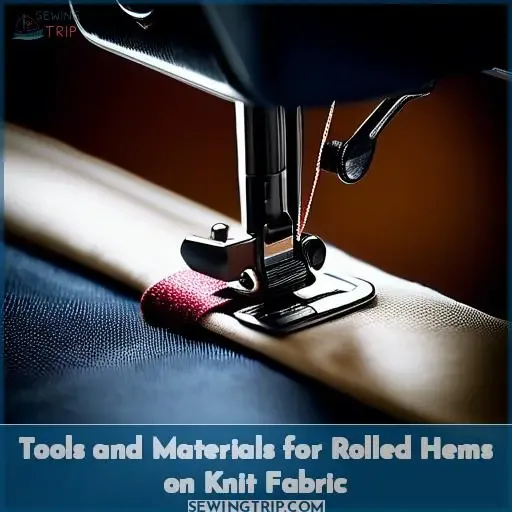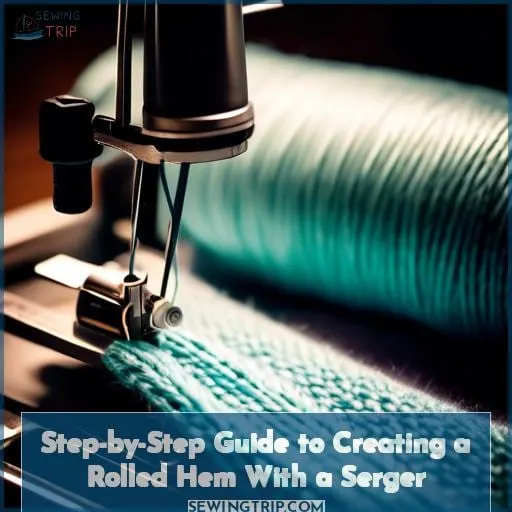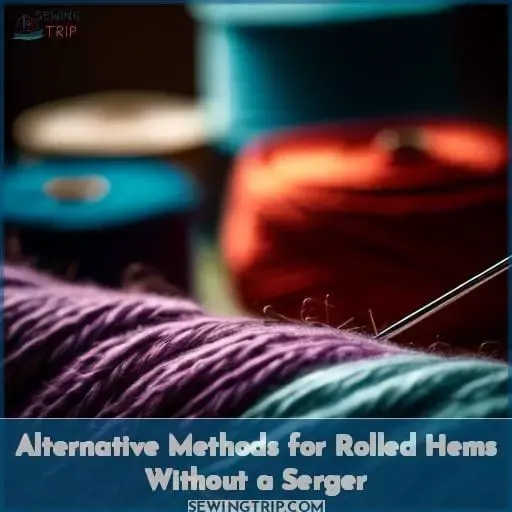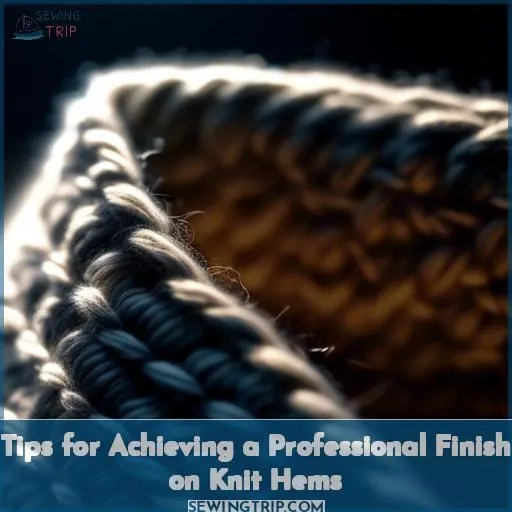This site is supported by our readers. We may earn a commission, at no cost to you, if you purchase through links.
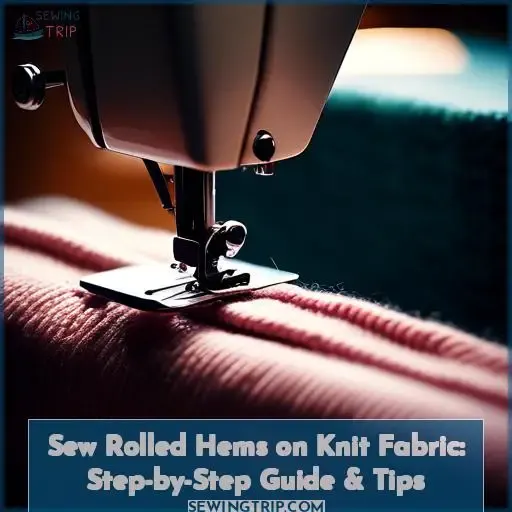
If you’re looking to master the art of sewing rolled hems on knit fabric, you’ve docked at the right harbor. This guide will illuminate the path from selecting the right tools and materials, through a detailed step-by-step process using a serger, to exploring alternative methods without one.
Along the way, you’ll gather invaluable tips to ensure your knit hems are not just finished, but professionally polished. Whether you’re a seasoned sailor or setting sail for the first time, let’s embark on this journey to conquer the waves of knit fabric together.
Table Of Contents
- Key Takeaways
- Understanding the Challenges of Hemming Knit Fabric
- Tools and Materials for Rolled Hems on Knit Fabric
- Step-by-Step Guide to Creating a Rolled Hem With a Serger
- Alternative Methods for Rolled Hems Without a Serger
- Tips for Achieving a Professional Finish on Knit Hems
- Frequently Asked Questions (FAQs)
- Conclusion
Key Takeaways
- Use a twin needle for a stretchy, flat hem that mimics a serged finish without requiring a serger. This tool is essential for achieving a professional look on knit fabric hems.
- Adjust serger settings, including tension and differential feed, to prevent puckering or wavy seams when creating a rolled hem with a serger. This ensures a clean, tight finish on knit fabrics.
- Employ knit-specific tools and materials, such as a rolled hem foot, knit-specific thread, and a walking foot, to manage the stretchiness of knit fabric and achieve a professional finish.
- Practice on scrap fabric before hemming your final garment to perfect the tension, stitch length, and differential feed settings. This step is crucial for both serger and sewing machine methods to ensure the best possible outcome.
Understanding the Challenges of Hemming Knit Fabric
Diving into the world of sewing, especially with knit fabrics, can feel like you’re trying to tame a wild beast. Knits stretch and dance under your needle, making them a slippery opponent for those aiming for that crisp, professional hem.
But fear not, brave sewer, for understanding the challenges is the first step to mastery.
Knit fabric’s stretch is both a blessing and a curse. It forgives fitting issues but mocks you at the hemming stage. The key to conquering this beast lies in the right tools and techniques. Needle selection becomes your sword; choose a ballpoint or stretch needle to avoid snagging the fabric.
Tension adjustment is your shield, protecting against puckered or wavy seams. Stitch length and fabric weight are the strategies you must adjust on the fly, ensuring your stitches are neither too tight to restrict stretch nor too loose to hold the hem.
Tools and Materials for Rolled Hems on Knit Fabric
Transitioning from the challenges of hemming knit fabric, we now delve into the toolkit essential for mastering rolled hems on these stretchy textiles. Knit fabric, with its cozy allure and forgiving stretch, demands a unique set of tools and materials to achieve that crisp, professional finish.
- Rolled Hem Foot: This nifty attachment for your sewing machine helps in guiding the fabric to roll neatly into place, ensuring a clean, tight finish.
- Twin Needle: Ideal for creating a twin needle rolled hem, this tool mimics the look of a coverstitch, giving your hems a stretchy, yet flat appearance without the need for a serger.
- Best Thread for Knit Fabric: Opt for a thread that has both strength and elasticity. A polyester thread or a woolly nylon thread can be great choices, ensuring your stitches stretch with the fabric without breaking.
- Overlock Stitch Settings on Your Serger: If you’re using a serger, adjusting the settings for a narrow overlock stitch is crucial. This involves reducing the stitch width and length to create a tight, rolled hem that won’t unravel.
With these tools and materials at your disposal, you’re well-equipped to tackle the nuances of binding with knit fabric, ensuring your hems aren’t just functional, but also aesthetically pleasing. Remember, the devil is in the details, and with the right setup, you’re on your way to hemming knits like a seasoned pro.
Step-by-Step Guide to Creating a Rolled Hem With a Serger
Creating a rolled hem with a serger is like performing a delicate dance with your fabric and machine. It’s a symphony of settings and adjustments, where each element plays a crucial role in the final performance.
First, serger tension is your dance partner. It can lead you to a flawless finish or step on your toes if not balanced just right. Imagine your serger’s tension dials as the hands of a clock, and you’re aiming for high noon.
Start with all dials at a midpoint, and adjust as needed, one tiny step at a time.
Next, the differential feed is the rhythm to your dance. It controls how the fabric flows under the needle, preventing puckers and waves.
Needle selection is like choosing the right shoes for your dance. A size 80/12 needle is a versatile choice for mid-weight knits, ensuring you don’t trip over skipped stitches.
Stitch length is the pace of your steps. Set it short, and your stitches will be close, creating a delicate edge.
Here’s a table to guide you through the setup:
| Step | Setting |
|---|---|
| 1. Serger Tension | Start at midpoint, adjust as needed |
| 2. Differential Feed | Set to normal (N) |
| 3. Needle Selection | Size 80/12 for mid-weight knits |
| 4. Stitch Length | Set to shortest (1 or 1. |
| 5. | |
| 5. Practice | Test on scrap fabric |
Now, take a deep breath, and let’s begin. With each adjustment, you’re one step closer to a hem that’s the envy of the ballroom. Keep your wits about you, and don’t let the serger tension tango intimidate you.
With a bit of patience and a sprinkle of humor, you’ll be rolling hems like a pro in no time.
Alternative Methods for Rolled Hems Without a Serger
As you’ve just seen, a serger can be your best friend when it comes to creating a sleek rolled hem on knit fabrics. But what if you’re serger-less and still want that crisp, professional edge? Fear not! You can still achieve a fabulous finish with a few clever tricks up your sleeve.
Let’s dive into the world of alternative methods that will have your hems rolling with the best of them, no serger required.
- Rolled Hem Tape: This nifty little helper can be your secret weapon. Simply iron it onto the edge of your fabric and fold over to create a clean line that won’t fray. It’s like magic without the wand!
- Fusible Web: Think of this as double-sided tape for fabric. A quick press with a hot iron, and you’ve got a hem that’s not going anywhere. It’s perfect for those fabrics that like to play hard to get.
- Rolled Hem Foot: If you’ve got a sewing machine, this attachment can be a game-changer. It might take a bit of practice, but once you get the hang of it, you’ll be rolling hems like a pro.
- Twin Needle: For a mock-serged look, a twin needle can create two parallel lines of stitching that keep your hem in place and add a touch of class.
Tips for Achieving a Professional Finish on Knit Hems
To ensure your knit hems are nothing short of spectacular, consider these savvy tips:
- Needle size matters: Like a painter choosing the right brush, select the needle that complements your fabric’s weight. A size 80/12 is a versatile choice for mid-weight knits, while a 90/14 can handle the heavier stuff.
- Tension adjustment is key: It’s a balancing act—too tight, and your hem will wave goodbye; too loose, and it’ll sag like a tired smile. Find that sweet spot where your stitches lie flat and even.
- Stitch length savvy: Long or short? That’s the question. A longer stitch length can prevent puckering, so don’t be afraid to stretch it out a bit, like a cat in the sun.
Frequently Asked Questions (FAQs)
How can I prevent my knit fabric from stretching out of shape while sewing a rolled hem?
To keep your knit fabric from stretching out while sewing a rolled hem, use a walking foot and knit stay tape for stability.
Opt for a ballpoint twin needle for stretchy, smooth hems.
Don’t pull the fabric; let the machine feed it evenly.
What are the best practices for selecting thread type and color for rolled hems on knit fabrics to ensure durability and aesthetic appeal?
For rolled hems on knit fabrics, opt for polyester thread for its stretch and resilience.
Match the thread color to your fabric for a seamless look, or go a shade darker to ensure it blends in beautifully.
Can a rolled hem be effectively used on all types of knit fabrics, including very lightweight or stretchy materials, without altering the fabric’s drape?
Yes, a rolled hem can be a magician’s trick for all types of knit fabrics, turning even the most rebellious, lightweight, or stretchy materials into well-behaved, beautifully draped garments.
It’s like waving a magic wand over your fabric, ensuring the drape remains as fluid as a river, without a hint of stiffness. However, mastering this spell requires a bit of practice and the right tools—namely, a serger with a special rolled hem stitch for that narrow, dense finish that hugs the fabric like a gentle embrace.
So, whether you’re dealing with a slinky jersey that dances with every movement or a delicate knit that whispers against the skin, a rolled hem can keep the magic of your fabric’s drape alive, ensuring your creations look nothing short of enchanting.
How do I correct mistakes or uneven stitching when creating a rolled hem on knit fabric, especially if I’ve already cut the fabric with a serger?
To fix uneven rolled hems on knit fabric, unpick the stitching.
Stabilize the fabric with wash-away tape or interfacing.
Re-serge carefully, avoiding fabric stretch.
If needed, adjust serger tension and use a walking foot.
Are there any specific techniques for adding decorative elements or finishes to a rolled hem on knit fabric to enhance the garment’s design?
To jazz up your rolled hem on knit fabric, consider adding a lettuce edge for a flirty flair.
You can also opt for a scalloped hem for a touch of elegance.
Both techniques are serger-friendly and can transform a simple hem into a statement finish.
Conclusion
Just as the first light of dawn transforms the dark horizon into a masterpiece of colors, mastering the art of sewing rolled hems on knit fabric can transform your sewing projects from simple to spectacular.
You’ve now navigated through the complexities of knit fabrics, armed with the right tools and techniques, whether using a serger or alternative methods.

